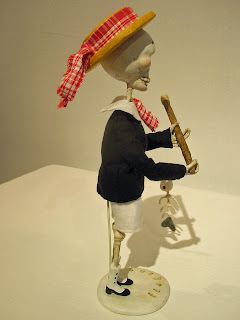Una vez imagine una criatura hibrida, mezcla de una nina y un cuervo, su cara era humana y de alguna manera iba a poder hacer sus rasgos como de ave, le iba a disenar ropa negra e incluso alas. Ademas iba a ser muy elegante.
I started with a wire skeleton and epoxy-clay limbs, they became so sturdy that she was able to stand up by herself! Her head was modeled in stone clay.
Comence con un esqueleto y miembros de plastilina epoxica, estos se pusieron tan duros que la muneca fue capaz de pararse sola! Su cabeza fue modelada en arcilla.
Because the wire skeleton, she was highly bendable, I could move her arms wherever pose I wanted, this was so much fun! Her shoulders and elbows could rotate as human joints do.
Debido al esqueleto de alambre fue posible que se moviera, pude acomodar sus brazos en cualquier pose que quisiera, sus hombros y codos se comportaban como si fueran humanos.
I painted her with acrylics, then made her some black bloomers.
La pinte con acrilicos y le hice unas pantaletas largas negras.
La muneca era complicada, me tomo varios dias terminarla, cuando le hice su vestido estaba tan nublado que tuve que salir al patio para coserselo a mano. Despues tome la foto sin un rayo de sol.
Her dress was made out of a very nice piece of fabric, it is textured, the leaves are black velvet, the fabric was part of a fashion designer's collection whom I am glad to count among my friends.
El vestido fue hecho de una tela bastante atractiva, esta texturizada y las hojitas son terciopelo negro, esta pieza estaba en la coleccion de una disenadora de modas que cuento entre mis amigos.
Wool is my favorite for making hair, it looks very realistic. For her dress I added some ruffles of very light fabric at the neck and end of sleeves.
La lana es mi material favorito para hacer cabello, se ve muy realista. Para terminar con el vestido cosi unos detalles en tela mas ligera en las mangas y el cuello.
She does noes not need the stand, but still I made it because I wanted to print her name somewhere, the idea was to use rubber stamps and print her name in English, Spanish, and Latin, why? I don't know, I just knew that was part of the plan.
No necesita el soporte, aun asi se lo hice porque queria imprimir su nombre en algun lugar, la idea era usar sellos e imprimir su nombre en ingles, espanol y latin, por que? No se, solo se que era parte del plan.
crow - corvus corax - cuervo
I made her some wings using the quilting technique, the great part is that these wings can be detached from the doll, she uses her wings whenever she wants!
Le hice sus alas con la tecnica del acolchado, lo mejor es que las alas se le pueden quitar y las usa solo cuando uno quiere!
From the beginning I had in my mind making a couple of dolls, she is The Crow, the older sister, next time get ready to meet The Dove.
Desde el principio tuve en mente hacer dos munecas, esta es el Cuervo, la hermana mayor, la proxima vez les presentare a La Paloma.
















































